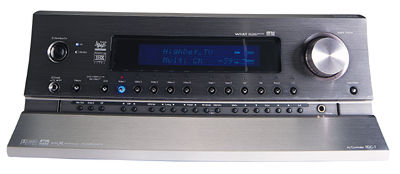Integra Research RDC-7 audio/video controller Page 2
In my past life as a custom installer, one of my best clients wanted a system timer. This fellow had a habit of staying up late watching movies on satellite but always hated to leave the system on all night. He was wearing out his projector by playing it too much—the CRTs' overall light output decreases with use—and such heavy use would waste valuable bulb life in the new fixed-pixel projectors as well. I remember many companies marketing separate timers in the 1980s, but these have been discontinued for years.
Apparently my old client is not alone in his late-night viewing habits, because Integra Research decided to include a sleep timer in the RDC-7. One push of the Sleep button at the top of the remote control begins a 90-minute countdown toward system shutoff. If you don't want to wait that long, each successive pressing of Sleep decreases the time limit by another 10 minutes.

Intellivolume
The RDC-7's input setup menu includes a handy feature that Onkyo calls Intellivolume. It solves a problem common in complex systems: different sources can have varied volume outputs. It can be unsettling if the tuner blasts loudly at the same volume setting used for a comfortable sound level from the DVD player. The RDC-7 has internal adjustments for each input, allowing a more even overall sound level from all inputs. Once this is set, it shouldn't need adjustment. The system keeps the programmed differences in memory; all you have to do is switch inputs and enjoy.
Accessories Included
Integra Research furnishes just about everything you might need to set up and enjoy the RDC-7. This includes the usual stuff: remote control, batteries, AM/FM antennas, warranty information, and so on. I was also pleasantly surprised to find a notice that announced a 7-day phone number for answers to operational questions, and an adapter with a DB-25 connector on one end and six RCA plugs on the other. The latter is needed for the 7.1-channel analog throughput (for sources such as DVD-Audio). These adapters are not easy to find; Monster Cable initially created a series of such cables when the connection was standardized, but they didn't sell immediately, and the marketing folks discontinued them.
Also enclosed were the 83-page owner's manual and a "Basic Operation Guide"—a four-page synopsis of the manual with condensed connection information and setup programming instructions. Naturally, I ignored both, trusting my 20 years of hi-fi experience to deliver musical nirvana. [We are professionals; do not try this at home.—TJN] There were no surprises—the back panel, remote control, and setup menu are well-laid-out and easy to understand, and the system was up and running in 30 minutes. The setup menu is very well-organized, and each step was intuitive. In this regard, I have never encountered a better processor.
One Smart Remote
The RDC-7's remote control is identical to the one supplied with the Integra DTR-9.1 receiver. When grasped with your index and middle fingers in the two slots on the underside, the remote faces forward with good balance, allowing for a single thumb's reach over two-thirds of the buttons. Each section of controls is differentiated by button shape and clear labels. And I just love that all of the buttons light up with a press of the top-right button. I have only one minor complaint: the Late Night button, which quiets loud sounds on most Dolby Digital DVDs, is labeled on the remote's plastic surface, not on the button itself. This makes finding it in the dark difficult, at least the first time. But once you know where it is, it's easy to locate by feel. Overall, this is one well-designed remote.
The remote can control seven other components in addition to the RDC-7, and comes programmed with infrared commands for other Onkyo models. It can be taught other remote languages easily with the common head-to-head learning process, and even has macro capability—with proper programming, the remote will issue a string of infrared commands with a single keystroke. This can tame even the most complex entertainment system, eliminating the juggling of multiple remotes. Imagine—press one button. Anyone in the house could actually turn on the system and enjoy it.








































